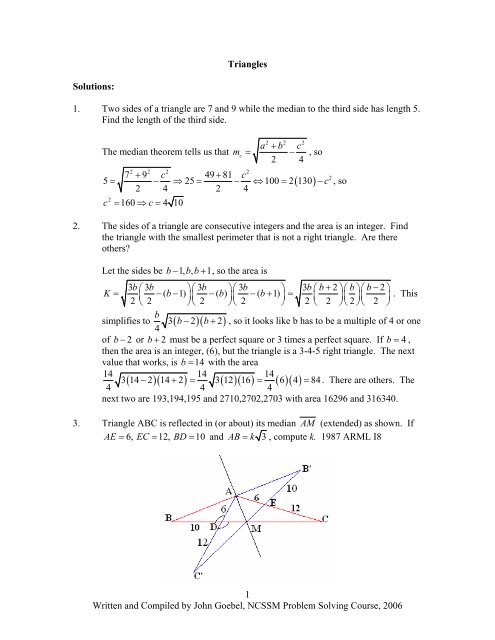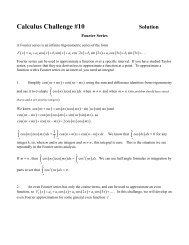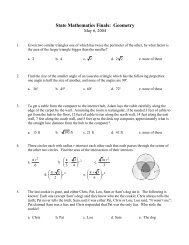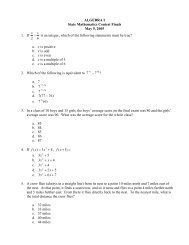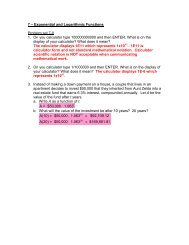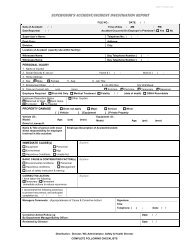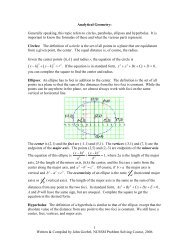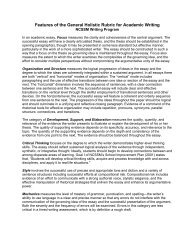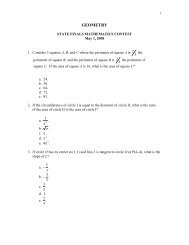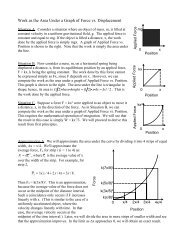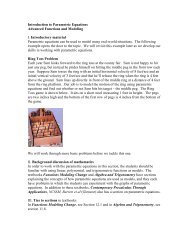Create successful ePaper yourself
Turn your PDF publications into a flip-book with our unique Google optimized e-Paper software.
Triangles<br />
Solutions:<br />
1. Two sides of a triangle are 7 <strong>and</strong> 9 while the median to the third side has length 5.<br />
Find the length of the third side.<br />
2 2 2<br />
a + b c<br />
The median theorem tells us that mc<br />
= − , so<br />
2 4<br />
7 + 9 c 49 + 81 c<br />
5 25 100 2( 130)<br />
2 4 2 4<br />
c<br />
2 2 2 2<br />
2<br />
= − ⇒ = − ⇔ = − c , so<br />
2<br />
= 160 ⇒ c=<br />
4 10<br />
2. The sides of a triangle are consecutive integers <strong>and</strong> the area is an integer. Find<br />
the triangle with the smallest perimeter that is not a right triangle. Are there<br />
others?<br />
Let the sides be b−<br />
1, b, b+ 1, so the area is<br />
3b⎛3b ⎞⎛3b ⎞⎛3b ⎞ 3b⎛b+ 2⎞⎛b⎞⎛b−2⎞<br />
K = ⎜ −( b−1) ⎟⎜ −( b) ⎟⎜ − ( b+ 1) ⎟ = ⎜ ⎟⎜ ⎟⎜ ⎟<br />
2 ⎝ 2 ⎠⎝ 2 ⎠⎝ 2 ⎠ 2 ⎝ 2 ⎠⎝2⎠⎝ 2 ⎠ . This<br />
b<br />
simplifies to 3( b− 2)( b+ 2)<br />
, so it looks like b has to be a multiple of 4 or one<br />
4<br />
of b − 2 or b + 2 must be a perfect square or 3 times a perfect square. If b = 4 ,<br />
then the area is an integer, (6), but the triangle is a 3-4-5 right triangle. The next<br />
value that works, is b = 14 with the area<br />
14 14 14<br />
3( 14 − 2)( 14 + 2) = 3( 12)( 16) = ( 6)( 4)<br />
= 84 . There are others. The<br />
4 4 4<br />
next two are 193,194,195 <strong>and</strong> 2710,2702,2703 with area 16296 <strong>and</strong> 316340.<br />
3. Triangle ABC is reflected in (or about) its median AM (extended) as shown. If<br />
AE = 6, EC = 12, BD = 10 <strong>and</strong> AB = k 3 , compute k. 1987 ARML I8<br />
1<br />
Written <strong>and</strong> Compiled by John Goebel, NCSSM Problem Solving Course, 2006
The median AM divides triangle ABC into two triangles, ABM <strong>and</strong> CAM which<br />
both have the same area. Since B’AM is the reflection of BAM, <strong>and</strong> C’AM is the<br />
reflection of CAM, all of these triangles have the same area. Now look at<br />
triangles BAD <strong>and</strong> C’DM. They have the same area as well (take triangle ADM<br />
off of BAM <strong>and</strong> C’AM). the areas can be found using the formula<br />
1 1<br />
BD ⋅DA⋅sin( ∠ ADB) = C ' D ⋅DM ⋅sin ( ∠ MDC '), but since the angles are<br />
2 2<br />
equal, we have it has the same area BD⋅ DA⋅= C'<br />
D⋅ DM , so<br />
610 ⋅ = AD ⋅12⇒ AD = 5. So EM = 5 also. This makes CM = 15. Now the law<br />
2 2 2<br />
12 + 15 −5 344 43<br />
of cosines gives cos( ∠ C)<br />
= = = . Now in triangle ABC,<br />
2(12)(15) 360 45<br />
AB = 30 + 18 − 2(30)(18) = 900 + 324 − 2(2)(6)43 = 192 , so<br />
45<br />
AB = 192 = 8 3 .<br />
2 2 2 43<br />
4. Right triangle ABC (hypotenuse AB ) is inscribed in equilateral triangle PQR, as<br />
shown. If PC = 3, <strong>and</strong> BP = CQ = 2, compute AQ. ARML 1991 I7<br />
Using the law of cosines we can find BC, AC, <strong>and</strong> AB <strong>and</strong> then use the<br />
Pythagorean <strong>Theorem</strong> to relate these. First let AQ= x, AR= 5− x <strong>and</strong> note that<br />
2 2 2<br />
BR = 3. So, BC = 2 + 3 − 2(2)(3) (<br />
1<br />
) = 4 + 9 − 6 = 7 ,<br />
2<br />
2 2 2 2<br />
AC = 2 + x − 2(2)( x) (<br />
1<br />
) = x − 2x<br />
+ 4, <strong>and</strong><br />
2<br />
2 2 2 2<br />
AB = 3 + (5 −x) −2(3)(5 − x) (<br />
1<br />
) = x − 7x<br />
+ 19. So now we have<br />
2<br />
2 2<br />
x x x x<br />
( ) ( )<br />
− 7 + 19= − 2 + 4 + 7 , so 5x= 8⇒ x= 8 = 13<br />
.<br />
5 5<br />
5. In triangle ABC, the perpendicular bisector of AC intersects AC at M <strong>and</strong> AB<br />
at T. If the area of triangle AMT is 1 4<br />
the area of triangle ABC, <strong>and</strong><br />
o<br />
A+ C = 128 , compute the number of degrees in angle A. ARML 1988 I4<br />
2<br />
Written <strong>and</strong> Compiled by John Goebel, NCSSM Problem Solving Course, 2006
Since the area of AMT is one-fourth the area of ABC, the altitude MT must be<br />
half the altitude BP. Now, since MT is half of BP, AT = TB <strong>and</strong> AM = MP, but<br />
we know that AM = MC, so C must coincide with P, making triangle ABC a right<br />
triangle <strong>and</strong> since 128 o<br />
o<br />
m∠ A+ m∠ C = , m∠ A=<br />
38<br />
6. An isosceles triangle has a median equal to 15 <strong>and</strong> an altitude equal to 24. This<br />
information determines exactly two triangles. Compute the area of each of these<br />
triangles. ARML 1994 T4<br />
The two triangles are shown above, with BM the median with length 15 in the<br />
first <strong>and</strong> AF the altitude with length 24. In the first triangle, we know that<br />
2 2 2<br />
( 2x) + ( 2y) ( 2x)<br />
1 2 2<br />
15 = − = 4x<br />
+ 8y<br />
<strong>and</strong> ( ) 2 2 2<br />
2x<br />
= 24 + y , so<br />
2 4 2<br />
2 2<br />
2 2<br />
900 = 4x<br />
+ 8y<br />
<strong>and</strong> 576 = 4x − y , which makes<br />
2 2 2 2<br />
900 − 8y = 576 + y ⇔ 9y = 324 ⇒ y = 36 ⇒ y = 6 making the area 144. In<br />
2 2 2 w 2z<br />
5<br />
the second triangle we have w = 15 + z <strong>and</strong> = ⇒ 24w= 30z⇒ w= z,<br />
15 24 4<br />
3<br />
Written <strong>and</strong> Compiled by John Goebel, NCSSM Problem Solving Course, 2006
2<br />
⎛5 2 2 25 2 2 2 9 2 2<br />
so 15 15 15 20<br />
4 z ⎞<br />
⎜ ⎟ = + z ⇒<br />
16 z = + z ⇒<br />
16<br />
z = ⇒ z =<br />
⎝ ⎠<br />
which makes AF = 7 . Thus the area of this triangle is 300.<br />
<strong>and</strong> w = 25 ,<br />
7. Point P is inside ABC . Line segments<br />
APD, BPE, <strong>and</strong> CPE are drawn with D on BC , E on CA ,<br />
<strong>and</strong> F on AB . (See figure). Given that AP = 6, BP = 9,<br />
PD = 6, PE = 3 , <strong>and</strong> CF = 20 , find the area of ABC .<br />
AIME 1989 #15<br />
8. The points (0,0), (a,11), <strong>and</strong> (b,37) are the vertices of an equilateral triangle. Find<br />
the value of ab. AIME 1994 # 8<br />
9. A direct proof<br />
establishes that equal<br />
sides implies equal<br />
medians. If AB ≅ BC,<br />
then AN ≅ CM , <strong>and</strong><br />
since ∠MAC ≅∠ NCA<br />
<strong>and</strong> AC ≅ AC , we have<br />
MAC<br />
≅ NCA, so<br />
AM ≅ CN . To prove<br />
that equal medians implies equal sides, we can’t prove congruent triangles, so we will<br />
take an indirect approach. So we will assume the medians are equal, but the sides are not.<br />
So assume mAM = mCN , then<br />
2 2 2 2 2 2 2 2 2 2 2 2<br />
b + c a b + a c b + c a b + a c<br />
− = − ⇒ − = − ⇒ 2( b + c ) − a = 2( b + a ) −c<br />
2 4 2 4 2 4 2 4<br />
2 2 2 2 2 2 2 2<br />
, so 2b + 2c − a = 2b + 2a −c ⇒ 3a = 3c ⇒ a= c. This is really not an indirect<br />
proof, is it?<br />
2 2 2 2 2 2<br />
4<br />
Written <strong>and</strong> Compiled by John Goebel, NCSSM Problem Solving Course, 2006


